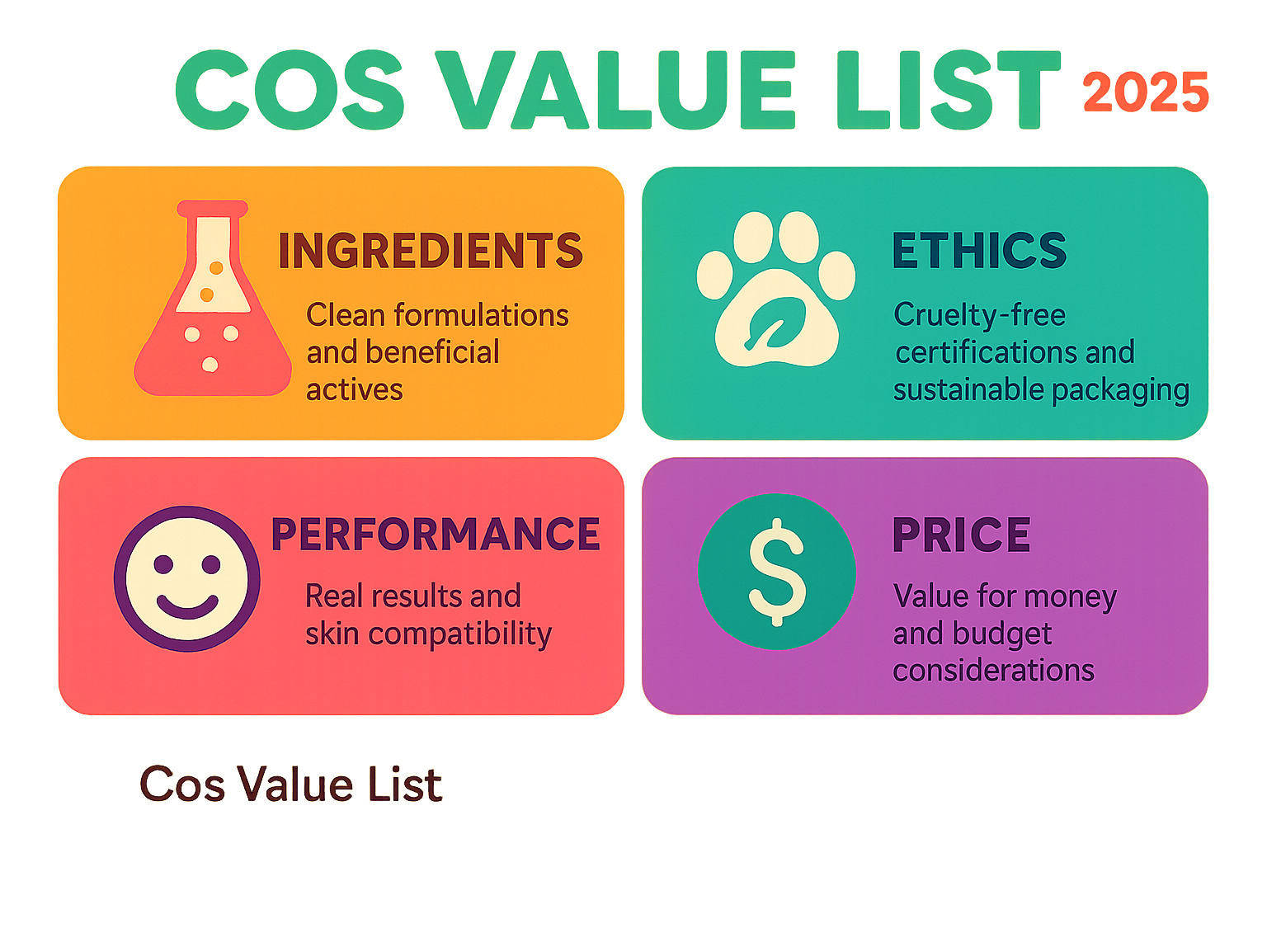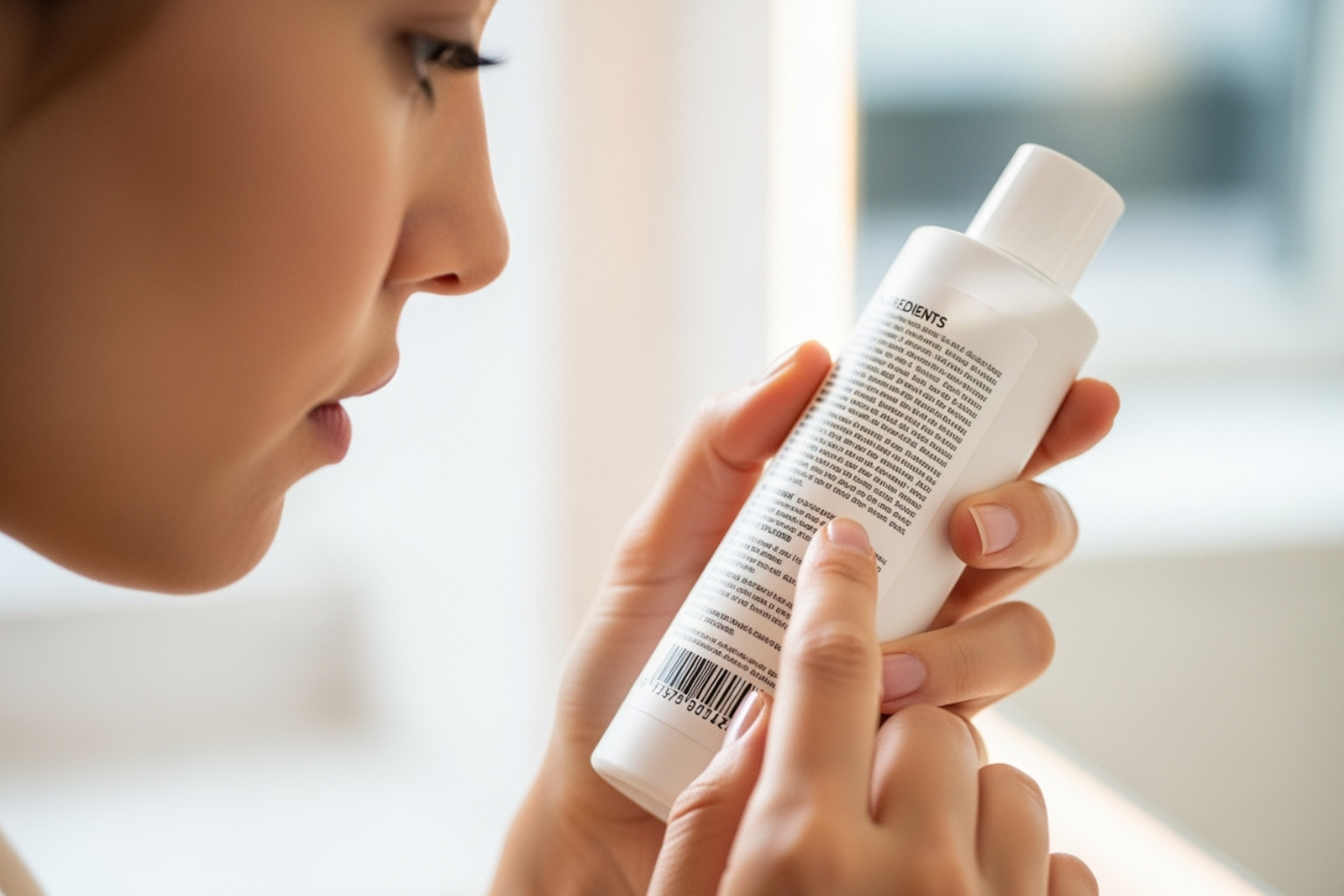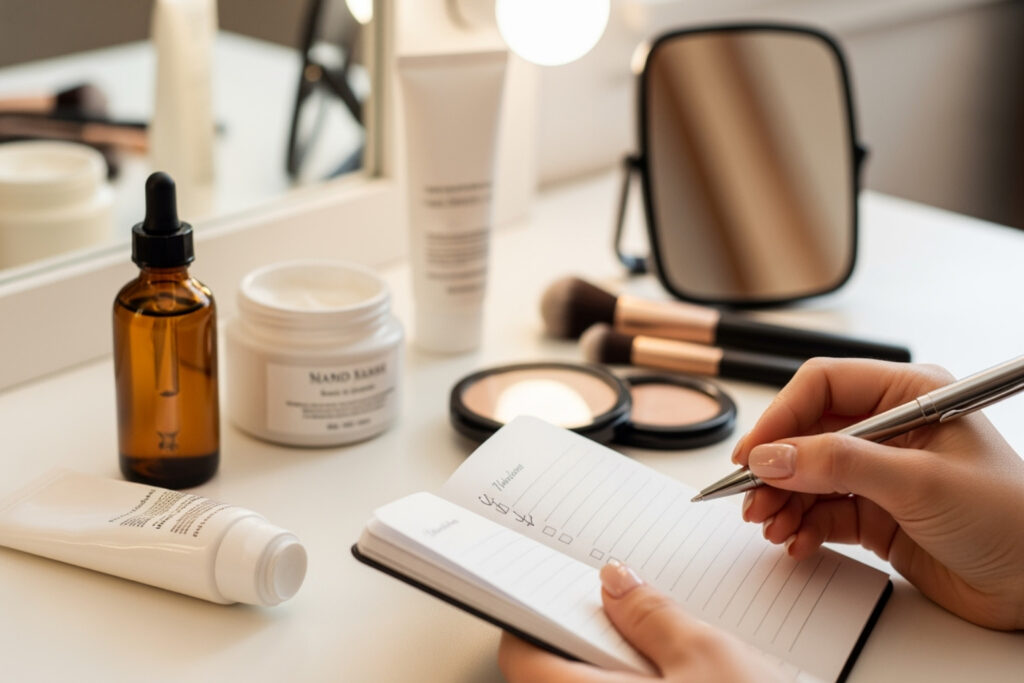Why Understanding Your Cosmetic Values Matters More Than Ever
A cos value list is your personal guide for evaluating beauty products based on ingredients, ethics, performance, and price to make informed purchasing decisions that align with your values and needs.
Quick Reference – What Makes a Strong Cos Value List:
- Ingredient Analysis – Non-toxic formulations with beneficial actives
- Ethical Standards – Cruelty-free, vegan, and sustainable practices
- Performance Metrics – Real results for your specific skin type
- Value Assessment – Quality-to-price ratio that fits your budget
In today’s beauty landscape, you’re faced with thousands of products promising everything from anti-aging miracles to natural glow. But how do you separate marketing hype from real value?
The truth is, most consumers spend money on products that don’t work for them simply because they lack a systematic approach to evaluation. Without clear criteria, it’s easy to fall for flashy packaging or influencer recommendations that may not suit your unique needs.
Creating your own cosmetic value framework empowers you to make conscious, informed choices that benefit both your skin and your wallet. This approach moves you beyond impulse purchases toward building a curated collection of products that truly deliver results.
Whether you’re new to clean beauty or looking to refine your routine, having a structured evaluation system helps you steer the overwhelming world of skincare and cosmetics with confidence.

1. Decode the Ingredient Label for True Worth

Think of ingredient analysis as the foundation of your cos value list – it’s like learning to read the DNA of your beauty products. Without this skill, you’re essentially shopping blindfolded, trusting marketing claims instead of facts.
The real treasure hunt begins when you flip that bottle over and examine the INCI list (International Nomenclature of Cosmetic Ingredients). This isn’t just a random jumble of scientific names – it’s your roadmap to understanding what’s actually touching your skin every day.
Ingredient safety should be your first priority. Many conventional products still contain questionable ingredients like parabens (preservatives that can disrupt hormones), phthalates (often hidden in “fragrance”), and synthetic fragrances that can trigger sensitivities. These aren’t just scary-sounding words – they represent real concerns that clean beauty brands actively avoid.
Here’s where it gets exciting: identifying beneficial actives. These are the superstars that actually work for your skin. Hyaluronic acid draws moisture like a magnet, vitamin C brightens and protects, and niacinamide strengthens your skin barrier. When you spot these powerhouse ingredients, you know you’re looking at a product with real potential.
But here’s the catch – understanding concentrations matters just as much as the ingredients themselves. An amazing active listed at the very end might be there in such tiny amounts that it won’t make a difference. Meanwhile, a high concentration of a potent ingredient could be incredibly effective or potentially irritating if it doesn’t match your skin type.
Learning to steer non-toxic ingredients becomes second nature once you know what to look for. You’ll start recognizing the good guys (like ceramides, peptides, and plant oils) and automatically scanning for the ingredients you’d rather avoid.
The beauty of mastering ingredient analysis is that it transforms you from a passive consumer into an informed decision-maker. You’ll find yourself naturally gravitating toward products that align with your values and skin needs, making your cos value list both personal and powerful.
Practical label-reading tips to boost your cos value list:
- Order matters: INCI lists are typically in descending concentration until about 1%; below that threshold, ingredients may appear in any order. This helps you gauge whether star actives are present at meaningful levels.
- Actives and formats: L-ascorbic acid (a form of vitamin C) is most effective at lower pH and moderate concentrations, while vitamin C derivatives (like sodium ascorbyl phosphate) tend to be gentler and more stable. Match the format to your skin tolerance and goals.
- Preservatives are protective: Safe, modern preservatives (such as potassium sorbate, sodium benzoate, ethylhexylglycerin, or phenoxyethanol typically at under 1%) prevent contamination. Their presence is a quality marker in water-based formulas.
- Fragrance transparency: “Fragrance/Parfum” can mask a mixture of scent ingredients. If you are sensitive, look for fragrance-free versions or watch for listed allergens (for example, limonene, linalool, citronellol) that may accompany perfumed products.
- Texture-building ingredients: Humectants (glycerin, propanediol), emollients (squalane, caprylic/capric triglyceride), and occlusives (shea butter) tell you how hydrating or rich a product will feel before you even open it.
30-second INCI scan checklist:
- Are the main hydrators and emollients appropriate for your skin type? (Lightweight for oily, richer for dry.)
- Is the hero active in the top half of the list, or plausibly effective given the format?
- Are potential irritants (strong fragrance, certain essential oils, high alcohol) aligned with your skin’s tolerance?
- Does the formula include a sensible preservation system for water-based products?
- Does it complement the rest of your routine (for example, avoid stacking multiple strong exfoliants)?
2. Assess Ethical and Sustainable Practices
Beyond what’s in the bottle, how a product is made and its impact on the planet are crucial components of your cos value list. This is where you evaluate a brand’s commitment to ethical and sustainable practices. Navigating terms like “clean,” “green,” and “sustainable” can be confusing, but understanding them is key to making choices that align with your values.
Clean vs. Green vs. Sustainable: What’s the Difference?
These terms are often used interchangeably, but they represent different levels of commitment. Here’s a simple breakdown:
| Category | Definition & Focus | Key Characteristics |
|---|---|---|
| Clean Beauty | Focuses on human safety. The primary concern is using non-toxic ingredients and avoiding potentially harmful chemicals like parabens, sulfates, and phthalates. | Non-toxic formulas, ingredient transparency, safe for skin. |
| Green Beauty | Focuses on environmental impact. Products are typically made from plant-based, natural, or organic ingredients. The emphasis is on being environmentally friendly. | Natural/organic ingredients, biodegradable formulas, minimal environmental harm. |
| Sustainable Beauty | A holistic approach that considers the entire lifecycle of a product. This includes ethically sourced ingredients, eco-friendly manufacturing processes, recyclable or refillable packaging, and the brand’s overall social responsibility. | Ethically sourced materials, cruelty-free practices, recyclable/minimalist packaging, reduced carbon footprint. |
Key Ethical & Sustainable Markers to Look For:
- Cruelty-Free Certifications: Look for official logos like the Leaping Bunny or PETA’s Beauty Without Bunnies to ensure no animal testing was involved at any stage of production.
- Vegan Formulas: This means the product contains no animal-derived ingredients or by-products, such as honey, beeswax, or carmine.
- Responsible Packaging: Is the packaging made from recycled materials? Is it recyclable or, even better, refillable? Brands committed to sustainability are moving away from single-use plastics.
- Corporate Social Responsibility (CSR): Investigate the brand’s broader impact. Do they support fair trade practices? Do they contribute to social or environmental causes? This is often part of a company’s Environmental, Social, and Governance (ESG) criteria.
By adding these ethical and sustainable checkpoints to your cos value list, you’re not just choosing products that are good for you, but also supporting brands that are good for the planet and its inhabitants.
Conclusion
Creating your personal cos value list isn’t just about making smarter beauty purchases – it’s about changing how you approach your entire skincare and makeup routine. When you take the time to evaluate products based on ingredients, ethics, performance, and price, you’re investing in both your skin’s health and your peace of mind.
Think of your cos value list as your beauty compass. Just like you wouldn’t buy a car without checking its safety ratings and reviews, your cosmetic choices deserve the same thoughtful consideration. This systematic approach helps you cut through marketing noise and focus on what truly matters for your unique needs.
The beauty industry can feel overwhelming with its constant stream of new launches and trending ingredients. But when you have clear criteria for evaluation, those flashy advertisements lose their power to sway you toward impulse purchases that might not serve you well.
Your cos value list evolves with you. As your skin changes with age, seasons, or life circumstances, your priorities might shift too. Maybe you’ll place more emphasis on sustainable packaging during certain phases, or focus heavily on performance when dealing with specific skin concerns.
Becoming a conscious beauty consumer is a journey, not a destination. Each product you evaluate using your cos value list teaches you something new about your preferences and values. You might find that certain ingredients work beautifully for your skin type, or that supporting cruelty-free brands brings you genuine satisfaction.
The ripple effects extend beyond your bathroom cabinet. When you make informed choices, you’re supporting brands that align with your values and encouraging the industry to prioritize transparency and quality over flashy marketing.
Start small if this feels overwhelming. Pick one product category – maybe your daily moisturizer or foundation – and apply these evaluation principles. As you build confidence in reading ingredient lists and assessing brand ethics, expand your cos value list to cover your entire routine.
Action steps to put your cos value list into practice:
- Patch test new products and track day-by-day observations for two weeks before deciding.
- Keep a simple spreadsheet or notes app with ingredient highlights, ethics flags, price per use, and results over 30 days.
- Refine your routine order to improve performance and reduce pilling or irritation; see Skincare Layering 101: The Right Order for Maximum Glow.
- If a product underperforms, troubleshoot first (application, frequency, pairing) with Why Your Skincare Isn’t Working and How to Fix It before replacing it.
- Align choices with budget and values using Clean Beauty on a Budget: Smart Tips for Glowing Skin, and shop intentionally via Where to Shop: Trusted Sites & Stores for Clean Beauty.
Your skin deserves products that truly work for you, and your values deserve to be reflected in your purchasing decisions. With your personalized evaluation system in hand, you’re ready to steer the beauty world with confidence and clarity.
Your journey to mindful beauty starts here, and every thoughtful choice you make brings you closer to a routine that truly serves you.







